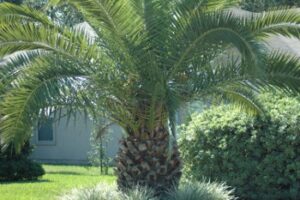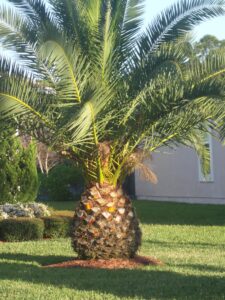S & J Nursery’s Guide to Growing
Canary Island Date Palms
/ Phoenix canariensis
in the Northeast Florida, Jacksonville | St. Augustine area Landscape
Canary Island Date Palm Origins:
– Phoenix Canariensis is native to the Canary Islands of North Eastern Africa and is widely cultivated as an ornamental palm in the North Florida area.
Canary Island Date Palm Preferred Exposure:
– Full sun is preferable in the North Florida landscape.
Canary Island Date Palm Fronds | Trunk:
– Foliage of the Canary Island Date Palm remains evergreen through the winter in the North Florida landscape and sustain no winter damage.
– One of the most decorative of all the Phoenix family of palms, the Canary Island Date Palm has a large stately head that reaches as much as 30 ft from left to right when mature. The fronds extending from the crown of the trunk may be 8 -15 ft in length and are very numerous, long fronds tend to arch gently towards the tips and have a graceful appearance.
– Long needle like thorns towards the base of the fronds closest to the
trunk.
– Trunks of the Canary Island Date Palm may eventually reach 50 ft in height and 4 ft in diameter, although with their slow growth, this may take quite a while.
– Old leaf fronds are removed completely from the trunk on the lowest portion of the palm and left at the top near the foliage, they are then trimmed on an angle to expose the diamond shape of the individual palm fronds. These fronds closest to the crown of the tree are cut at a distance of 1-2 ft from the trunk ( just below the last set of need like thorns) and pruned into a round shape giving the palm a “Pineapple” appearance. When properly pruned, these trees are a stunning landscape statement.
Canary Island Date Palm Soil Preference / Salt tolerance:
tolerance:
– Canary Island Date Palms planted in the North Florida | Jacksonville | St.
Augustine landscape will tolerate virtually any soil components, providing they are planted into well drained soils.
– Do not plant Phoenix Canariensis into water logged soils
– Salt tolerance is moderately high and Phoenix Canariensis palms may be planted on the street side of ocean front properties
Canary Island Date Palm Size Variance:
– Phoenix canariensis palms can reach sizes of 50-60 feet H | and spreading 16-30 feet in width.
Canary Island Date Palm Growth Habit:
– Canary Island Date Palm has a broad spreading tree and although slow to develop any trunk height these trees quickly develop 8-15 ft long fronds. Give them plenty of room in the landscape for their foliage to spread.
Canary Island Date Palm Growth Rate:
– Like much of the Phoenix family of palms, Phoenix canariensis palms are extremely slow growing and may develop only 3-6 inches of trunk each growing season.
– Fronds develop length quickly and within 3-5 years after being planted from the average 30 gallon palm you can expect your trunk to have a 2 ft by 2 ft pineapple and fronds 15 ft across from left to right.
Canary Island Date Palm Bloom:
– White clusters give way to yellow – orange fruits.
Canary Island Date Palm Water Requirements:
– Drought tolerant once established into the landscape. Take care to water well for the first few months after being planted from and S & J Nursery container into the landscape.
Best Uses For Canary Island Date Palm in the North Florida | Jacksonville | St. Augustine landscape:
– Canary Island Date Palm is an excellent choice for a landscape statement for larger yards and commercial buildings where their huge highly decorative heads can be fully appreciated.
Care of Phoenix canariensis / Canary Island Date Palms:
– Canary Island Date Palms will need good water during the establishment period and are drought tolerant once established into the landscape.
– Trim back damaged or older browned out fronds each year as needed at the base of the stem to keep the plant at its best. Be sure to prune just past the last set of needle like thorns, removing those thorns when pruning older fronds helps keep the trunk size uniform on all sides and much safer to be
working around!
MINIMUM PALM FERTILIZER REGIMEN – what you should be doing to keep your palm healthy once it has had time to root in and begin growing into its new home. ( after the establishment period, see caution below in red)
– Fertilize each spring with a specially blended fertilizer for Palms, follow
manufacturers directions and apply 1/2 lb o 1lb of fertilizer per inch of diameter of trunk on your palm, measured from a hands width above the ground level. That means for a 12 inch wide trunk from left to right you
would need 6-12 lbs of fertilizer for just that one palm!
– Fertilize every fall with magnesium sulfate ( Epsom Salt) to keep your palm green and healthy through the winter months!
MAXIMUM PALM FERTILIZER REGIMEN – what you can do to get your palm up and growing
Fast!
– Fertilize every three months with your choice of Palm fertilizer and
Magnesium Sulfate. Water 3-4 times per week and make sure to water thoroughly after each fertilizer application.
– Wait till fronds have turned completely brown before removing from the palm as the palm will take back in the nutrients from those older leaves ad use it when forming new ones.
*CAUTION – DO NOT FERTILIZE NEWLY PLANTED / TRANSPLANTED
FIELD GROWN PALM TREES WITH PALM FOOD!
Note : When planting smaller palms being grown in a container, this rule does not apply, rather, use half the recommended application rate for your trunks diameter, as container grown palms roots have not been damaged or cut during planting but are still only a portion as large as they would be if the palm had been growing in the ground and excess fertilizer on a confined root system is still not preferable for maximum health.
Palm fertilizers are water soluble and will burn the new roots your palm tree is trying to put out as it establishes itself into the landscape. It is best to use only poly coated plant food that is heat release like Osmocote general purpose fertilizer or non burning Milorganite in the first year in the landscape, and then the following year, start your palm food regimen that will provide all of the minor nutrients that your palms will need to keep them healthy and problem free in Florida’s soils.


